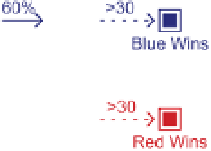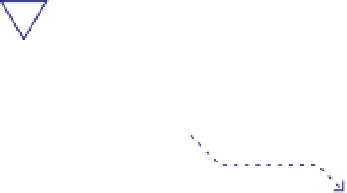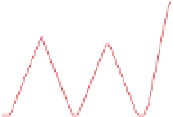Game Development Reference
In-Depth Information
a typical game session and indicates spreads of possible outcome. Obviously, the
blue player is going to win nearly all the time.
FIGURe 6.38
an unequal race
Many racing games use a technique called
rubber banding
to counter this effect.
Rubber banding is a technique of applying negative constructive feedback based on
the distance between the player and his artificial opponents in order to make sure
that they stay close. We have seen a construction like this already with LeBlanc's
example of negative feedback basketball. In that discussion, we pointed out that
while negative feedback used like this might keep the players close together, it will
not really make a poorer player win more often. However, there are adjustments
that can be made to the rubber-banding mechanism to change that. If the nega-
tive feedback is made stronger and lasts for a time, its effects are changed.
Figure
6.39
represents this type of rubber banding. The blue player has a skill level of 60%,
while the red player has a skill level of 40%, so blue generates distance more quickly
than red. The register at the right computes the difference in distance and, depend-
ing on which one is ahead, will signal their
Boost
source to generate a boost. The
boost lasts for 20 time steps, and each boost will improve the player's performance
by 5%. The chart displays a typical game session that results from this mechanism.
Note that the chart shows a race in which red and blue take the lead alternately.
NOTE
We have inten-
tionally implemented
an extreme form of rub-
ber banding to make
it more visible. real
games would use more
subtle boosting.
FIGURe 6.39
rubber banding with
strong and durable
negative feedback


























































